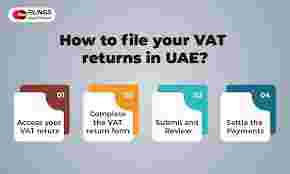Value Added Tax (VAT) is a key component of the UAE’s tax system, implemented to enhance government revenues while maintaining economic stability. For businesses registered under the UAE Federal Tax Authority (FTA), filing VAT returns accurately and on time is mandatory. As we step into 2025, it’s essential for businesses to stay updated on the latest VAT filing requirements and documentation to avoid penalties.
This article provides a detailed guide on how to file VAT return UAE and highlights the necessary documentation and processes involved.
Understanding VAT Filing Requirements in UAE
VAT returns must be filed periodically by VAT-registered businesses in the UAE. The process involves reporting the VAT collected on sales (output tax) and VAT paid on purchases (input tax). The difference between these amounts determines the net VAT payable or refundable.
Key documentation needed to file VAT returns includes:
-
Tax Invoices Received 2025: Accurate tax invoices for all purchases and expenses are vital for claiming input VAT credits. These invoices must comply with the FTA guidelines and contain detailed information such as VAT registration numbers, invoice date, and VAT amounts.
-
Credit Notes 2025 & Debit Notes 2025: Businesses must maintain proper records of credit and debit notes issued or received during the VAT period. These notes adjust the value of previously invoiced transactions and affect the VAT amounts to be declared.
-
VAT Adjustments 2025: Adjustments may be required to correct errors, account for bad debts, or reflect changes in business transactions. Keeping detailed records of these adjustments ensures accurate VAT reporting.
Filing VAT Return UAE: Step-by-Step Process
-
Gather All Relevant Documents: Compile tax invoices, credit and debit notes, and VAT adjustment records for the tax period.
-
Prepare VAT Working Papers 2025: Organize your accounting entries and calculations, ensuring all VAT amounts are correctly tallied.
-
Reconcile with VAT Audit File 2025: The VAT audit file contains detailed transactional data that auditors may review. Ensure this file is accurate and complete.
-
Complete the VAT Return Form: Log into the FTA online portal, enter all required information based on your collected documents, and verify the accuracy of input and output VAT.
-
Submit the Return: After a thorough review, submit the VAT return through the FTA portal by the deadline.
-
Keep FTA Correspondence 2025: Save all correspondence from the FTA, including notifications, queries, or audit requests for future reference.
Why Is Accurate Documentation Important?
The FTA closely monitors VAT submissions and conducts audits to verify compliance. Failure to maintain proper records like Tax Invoices Received 2025, Credit Notes 2025, or VAT Working Papers 2025 can result in fines or legal consequences. Moreover, a complete VAT Audit File 2025 helps in smooth audit processes, avoiding unnecessary disruptions.
Conclusion
Filing VAT returns in the UAE in 2025 requires meticulous preparation and accurate documentation. By maintaining comprehensive records such as Tax Invoices Received 2025, VAT Adjustments 2025, and Credit Notes 2025, businesses can ensure compliance and avoid penalties. Leveraging organized VAT Working Papers 2025 and maintaining the VAT_Audit_File_2025 will simplify the filing process and provide a reliable trail for any FTA audits.
FAQ: Filing VAT Return UAE 2025
Q1: How often should VAT returns be filed in the UAE?
VAT returns are typically filed quarterly, but some businesses may be required to file monthly depending on turnover or FTA directives.
Q2: What documents are essential for filing VAT returns?
Essential documents include tax invoices, credit and debit notes, VAT adjustments, working papers, and any correspondence from the FTA.
Q3: Can I adjust VAT on credit and debit notes after filing a return?
Yes, adjustments can be made in subsequent VAT returns, but proper documentation must be maintained.
Q4: What is the VAT audit file, and why is it important?
The VAT audit file is a detailed report of all transactions related to VAT. It is essential for audit purposes and must be accurate and readily available.
Q5: How can I access FTA correspondence related to VAT?
FTA correspondence can be accessed through the FTA online portal under your business account.




